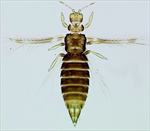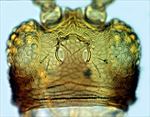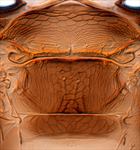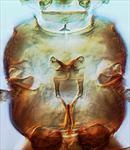
Female

Antenna

Antennal segments IV-V

Head

Head & thorax

Mesonotum & metanotum

Thoracic furcae

Tergites VII-X

Fore wing
Both sexes fully winged. Body brown, head with pair of yellow longitudinal areas; legs yellow, mid and hind femora brown; III–V largely yellow; fore wing brown but pale at apex and sub-basally, and with submedian area variably lighter. Antennae 8-segmented, segments III & IV each with a forked sense cone. Head reticulate with transverse occipital ridge; ocellar setae III on anterior margins of triangle; three pairs of postocular setae present. Pronotum with no long setae. Mesonotum reticulate on anterior half, lateral setae small. Metanotum reticulate medially, median setae arise medially. Tarsi all 2-segmented. Fore wing with two complete rows of setae, posteromarginal cilia wavy. Abdominal tergites weakly reticulate medially, median pair of setae small; posterior margins without a craspedum, VIII with comb of microtrichia laterally; tergite X with longitudinal split almost complete.
Male with sternal marginal setae minute. Sternites III–VII with slender transverse pore plate.
There are eight species recognized in the genus Hercinothrips. Each of these is originally from Africa, but two of them are now widespread around the world, and a third species, H. dimidiatus, has been introduced to Europe (Mateus et al., 2015). H. femoralis is very similar to H. bicintus (Bagnall), but has the fore wings more extensively dark. Hercinothrips species all have 2-segmented tarsi, and both longitudinal veins on the forewing bear a complete row of setae.
Breeding on the leaves of many different and unrelated plant species, including several crops, and sometimes causing leaf damage to plants, usually under glass, including bananas (Roditakis et al., 2006).
Originally from Africa, but now widespread around the world in tropical and subtropical areas (Roditakis et al., 2006).
THRIPIDAE - PANCHAETOTHRIPINAE
Hercinothrips femoralis (Reuter)
Heliothrips femoralis Reuter, 1891: 166
Heliothrips cestri Pergande, 1895: 390
Heliothrips apicalis Bondar, 1931: 86
Mateus C, Franco JC, Caetano MF, da Silva EB, Ramos AP, Figueiredo E & Mound L (2015) Hercinothrips dimidiatus Hood (Thysanoptera: Thripidae), a new pest of Aloe arborescens Miller in Europe. Phytoparasitica 43(5): 689–692.
Roditakis E, Mound LA & Roditakis NE (2006) First record in Crete of Hercinothrips femoralis in greenhouse banana plantations. Phytoparasitica 34: 488–490.